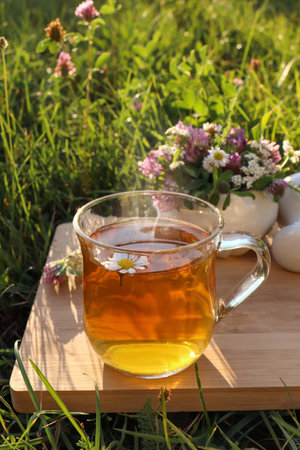Roots in Folk Traditions
Herbal tea has deep roots in the everyday life of the United Kingdom, long before it became a modern wellness trend. In traditional British households, making herbal infusions was a practical and comforting ritual, often handed down through generations. People would gather local herbs such as chamomile, nettle, elderflower, and peppermint from nearby fields, hedgerows, and gardens. These natural ingredients were prized not only for their soothing flavours but also for their perceived healing properties. Whether it was a mug of mint tea to settle the stomach after a hearty meal or a calming infusion of lavender at bedtime, these homemade brews were trusted remedies for minor ailments and moments of rest alike. The practice reflected a close relationship with nature and the rhythm of the seasons, as families relied on what grew around them to support both health and daily comfort. Herbal teas thus became an integral part of British folk tradition—a gentle blend of practicality, self-care, and connection to the land.
Herbal Lore and British Heritage
Britain’s relationship with herbal tea is steeped in centuries of myth, legend, and rural tradition. From the rolling hills of the Cotswolds to the wild moors of Yorkshire, the British countryside has long been a treasure trove of botanical remedies. Before herbal teas became fashionable in urban tearooms, they were woven into the very fabric of everyday life through folk beliefs and practical customs passed down through generations.
Stories abound in local lore—elderflower was said to ward off evil spirits, while chamomile was prized for calming nerves after a hard day’s work on the land. Herbal infusions were not merely sipped for pleasure; they served as a lifeline in times when formal medicine was scarce or inaccessible. Village healers and wise women often relied on their deep knowledge of native herbs, blending them into soothing brews that became household staples.
Traditional Herbal Teas and Their Folklore
| Herb | Folkloric Use | Associated Belief |
|---|---|---|
| Nettle | Spring tonic | Cleanses the blood after winter |
| Elderflower | Fever remedy | Protects against evil and misfortune |
| Chamomile | Calming infusion | Brings restful sleep and peace of mind |
| Mint | Aid for digestion | Attracts good luck to the household |
| Lemon Balm | Mood booster | Lifts spirits during troubled times |
The Role of Countryside Customs in Tea Culture
Rural communities often gathered wild herbs from hedgerows and meadows, following ancient rituals tied to the changing seasons. These traditions helped cement herbal tea as both a daily comfort and a seasonal necessity—nettles picked fresh in spring, elderflowers gathered at midsummer, and mint harvested at its aromatic peak. Such customs didn’t just shape local diets; they fostered a sense of connection to nature that still influences Britain’s modern wellness scene.

3. Victorian Society and Herbal Tonics
The Victorian era marked a turning point in the British relationship with herbal tea, as these infusions made a notable journey from humble kitchen gardens to the refined setting of parlour tea trays. During this period of rapid industrialisation and scientific discovery, traditional herbal remedies began to attract new attention, not only for their folkloric value but also as subjects of burgeoning medical interest.
From Garden Plot to Apothecary Shelf
Victorian households, particularly those in rural areas, continued the age-old custom of growing herbs like chamomile, peppermint, and elderflower just outside the back door. Yet, as interest in health and wellness grew among the urban middle classes, apothecaries started to blend and bottle these same botanicals as tonics and tinctures. It wasn’t uncommon for families to keep a small selection of herbal concoctions at hand—ready to soothe indigestion after a heavy meal or calm frazzled nerves after a long day navigating the city’s bustle.
The Genteel Ritual of Tea
While black tea firmly established itself as a social staple, herbal infusions gained popularity as both a healthful alternative and a genteel gesture. Hosting afternoon tea became an art form in Victorian drawing rooms, and offering a choice of calming lemon balm or invigorating nettle alongside more traditional brews reflected both hospitality and modern sensibility. This shift was not merely about taste—it was deeply tied to changing attitudes about self-care and the importance of balance in daily life.
Wellness Meets Respectability
Herbal teas thus found themselves at the intersection of tradition and progress. No longer relegated solely to the realm of folk medicine, they were embraced by society’s well-heeled as part of a respectable approach to health. The use of herbal infusions during this era set the stage for their continued evolution—from practical remedy to cherished element of British wellbeing culture.
4. The Mid-20th Century Decline
The mid-20th century marked a significant turning point in the story of herbal tea in the United Kingdom. With the growing popularity and mass production of black tea, especially after World War II, traditional herbal brews began to fade from everyday life. Black tea, affordable and easy to prepare, became the drink of choice for most British households, symbolising comfort and familiarity. The convenience of pre-packaged teabags and the rise of supermarkets made black tea even more accessible, leaving many herbal infusions to linger only in rural corners or as family traditions.
As lifestyles evolved and urbanisation increased, people gravitated towards products that suited their fast-paced routines. Herbal teas, often requiring fresh ingredients and longer steeping times, were seen as old-fashioned or cumbersome by comparison. Yet, despite this decline, some time-honoured remedies persisted in certain communities—elderflower cordial remained a summer staple in country homes, chamomile was still brewed for sleepless nights, and peppermint continued to soothe upset stomachs. These enduring favourites survived thanks to local knowledge passed down through generations.
Factor |
Impact on Herbal Tea |
|---|---|
Mass Production of Black Tea |
Became widely available and affordable; overshadowed herbal varieties |
Changing Lifestyles |
Faster pace led to preference for convenience; traditional brews declined |
Cultural Shifts |
Herbal teas perceived as outdated; black tea seen as modern British staple |
Persistence of Tradition |
Certain herbal brews survived in rural areas and within families |
This period set the stage for future rediscovery, reminding us that while trends may change, the roots of tradition can hold firm beneath the surface.
5. Revival and the Modern Wellness Movement
The latter part of the twentieth century and the early twenty-first have witnessed a remarkable revival in the popularity of herbal tea across the United Kingdom. This resurgence is closely intertwined with broader health trends, a growing emphasis on mindfulness, and an invigorated interest in British botanical heritage. As more people seek natural ways to support their wellbeing, herbal teas have found their place at the heart of contemporary lifestyles.
Health Trends and Holistic Living
Modern Britons are increasingly conscious of what they consume, often favouring organic, locally sourced ingredients. Herbal teas, once considered quaint or old-fashioned, now align perfectly with a holistic approach to health—offering gentle support for digestion, sleep, immunity, and stress relief. Tisanes such as chamomile, nettle, elderflower, and peppermint are no longer relegated to the back of the cupboard but celebrated for their traditional benefits and subtle flavours.
Mindfulness and Ritual
Beyond physical health, the ritual of preparing and enjoying a cup of herbal tea has become symbolic of self-care and mindfulness. In a culture where life can be hurried and hectic, pausing for an infusion crafted from wildflowers or garden herbs offers a moment of tranquillity—a simple act that reconnects us with the rhythms of nature and our own sense of balance.
Rediscovering Hedgerow Heritage
This modern movement is also rooted in a renewed respect for the British countryside. Urban dwellers and rural communities alike are rediscovering the bounty of hedgerows, foraging for native botanicals like elderberries, rosehips, and blackberry leaves. Workshops and local festivals celebrate these age-old practices, while artisan producers blend heritage knowledge with contemporary tastes to create unique infusions that honour both past and present.
The story of herbal tea in Britain is thus one of continuity as well as change—a tradition revitalised by modern values, yet always grounded in the wisdom of nature and community.
6. British Identity and the Ritual of Herbal Tea Today
In modern Britain, herbal tea has evolved from a humble folk remedy into an integral part of daily life, embodying both national identity and a growing appreciation for wellbeing. The ritual of brewing and sharing herbal infusions is woven into the fabric of contemporary British culture, offering a gentle counterpoint to the fast-paced demands of urban living. From the rustic comfort of country kitchens to the welcoming nooks of independent tea shops scattered across bustling cities, people gather over steaming mugs not just for refreshment but as a mindful act of self-care.
Herbal tea rituals are now embraced as moments to pause, reflect, and reconnect—whether enjoyed in solitude during a quiet morning or shared with friends in cosy surroundings. These simple acts nurture a sense of community and foster connections that reach beyond the teacup. As more Britons prioritise slow living and holistic health, herbal teas have become symbols of this shift: chamomile for calm evenings, peppermint for post-meal comfort, or elderflower for a nostalgic nod to countryside traditions.
The popularity of local blends and seasonal botanicals also reflects Britain’s renewed interest in sustainability and provenance. Many seek out locally sourced herbs or experiment with homegrown infusions, reviving age-old practices while adapting them to suit modern lifestyles. Through these evolving rituals, herbal tea continues to support not only individual wellness but also a collective longing for balance—a gentle reminder that amidst life’s busyness, there is always time for a restorative brew.


